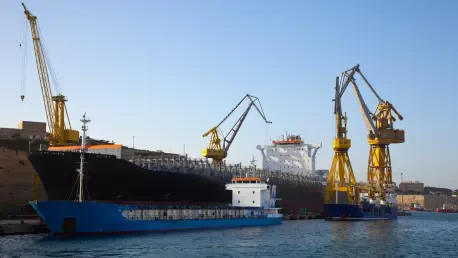The transition in global trade dynamics has intensified the demand for multipurpose and heavy-lift vessels, fundamentally transforming the breakbulk shipping sector. This development stems from increasing international infrastructure projects alongside expansions within the energy sector, necessitating adaptation by transportation and logistics providers. The shifting landscape highlights the complexity and interconnectivity of global trade routes, presenting both challenges and opportunities for industry stakeholders. A multifaceted approach is imperative to navigate these evolving conditions and to capitalize on them. An in-depth examination of the recent Breakbulk Shipping Quarterly Intelligence Report provides executives with insights essential for making informed strategic decisions.
The report offers a comprehensive perspective by analyzing breakbulk and project cargo shipping trends. It emphasizes a three-month outlook, taking into account various essential sectors such as global trade impacts on the breakbulk market and the availability of multipurpose and heavy-lift vessels. Furthermore, it evaluates the charter market, providing a nuanced understanding of supply-demand balances within the shipping vessel segment. This meticulous study illustrates cautious optimism among industry leaders concerning freight volume growth, necessitating proactive communication and accountability efforts both within and among organizations. With detailed offerings backed by expert opinions, the report aims to foster highly strategic operational capabilities.
Forces Fueling Vessel Demand
Global infrastructure projects are at the forefront of driving demand for multipurpose vessels. The energy sector’s expansion, especially with renewable energy projects, similarly plays a critical role in this heightened need. These sectors require multipurpose vessels capable of transporting diverse cargo types and sizes, from large-scale construction materials to specialized equipment for energy generation. As international commerce evolves, infrastructure and energy projects symbolize not only growth but also the potential for collaboration across oceans. To address the emerging complexities, industry players are actively enhancing operational efficiencies to ensure a seamless supply of shipping vessels.
The supply-demand equilibrium in the shipping vessel market is a significant focal point, reflecting fluctuating dynamics that call for measured responses from industry leaders. Operational efficiencies are prioritized, with digital solutions aiding asset management and logistical planning. Stakeholders are compelled to embrace a comprehensive overview of vessel availability and demand trends, channeling innovative solutions to facilitate symmetry between supply and demand. These efforts promote improved utilization of vessel fleets, thus sustaining capacity while minimizing environmental impacts. The report’s insights are invaluable, facilitating knowledge exchange and fostering a collaborative environment for adapting to industry-wide transformations.
Strategic Insight and Data Utilization
The strategic role of data is pivotal in navigating breakbulk market transformations, making such data indispensable in aligning business practices with emerging market demands. Enhanced data utilization through platforms like Gateway and comprehensive reports such as the Intermodal Savings Index and Service Scorecard empower subscribers with vital information on intermodal efficiencies versus long-haul trucking. This empowerment is integral for stakeholders to optimize their logistical strategies amid demanding trade scenarios. The data-driven approach not only informs stakeholders but also contributes to practical solutions ensuring responsiveness and streamlined operations.
With over 125 charts and exhaustive analysis, subscribers are equipped with a thorough understanding of market dynamics, fundamentally improving decision-making processes. Through these resources, subscribers gain access to key performance metrics that enable the identification of trends and the development of future-forward strategies. By leveraging data, stakeholders can maintain a competitive edge and adapt to evolving conditions with agility. This, in turn, facilitates industry adaptation, safeguarding growth trajectories while fulfilling emerging market needs. As the breakbulk shipping landscape continues to evolve, data remains a cornerstone, guiding stakeholders toward profitable horizons.
Navigating the Future of Breakbulk Shipping
The evolution of global trade dynamics has heightened the demand for multipurpose and heavy-lift vessels, significantly altering the breakbulk shipping industry. This shift is driven by growing international infrastructure projects and expansions in the energy sector, compelling transportation and logistics companies to adapt. The changing landscape underscores the complexity and interconnectedness of global trade routes, offering both challenges and opportunities for industry players. A comprehensive strategy is crucial to navigate these evolving conditions and leverage them effectively.
The Breakbulk Shipping Quarterly Intelligence Report provides key insights for executives to make informed strategic choices. It analyzes breakbulk and project cargo shipping trends with a three-month forecast, considering the impacts of global trade on the breakbulk market and the availability of multipurpose vessels. Additionally, it assesses the charter market, offering a detailed view of supply-demand balances in the shipping sector. The report reveals cautious optimism among industry leaders regarding freight volume growth, emphasizing the need for proactive communication and accountability within organizations.









